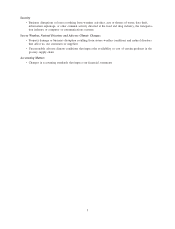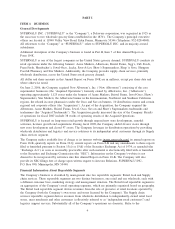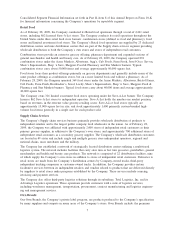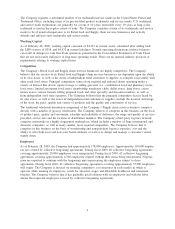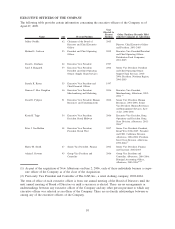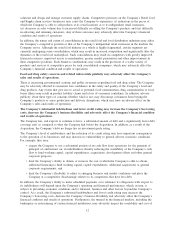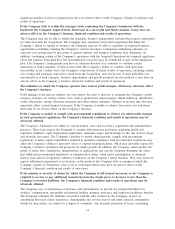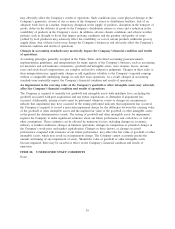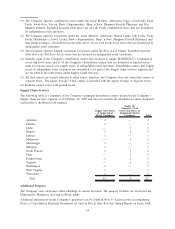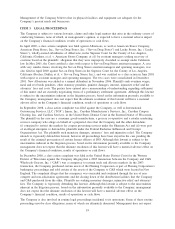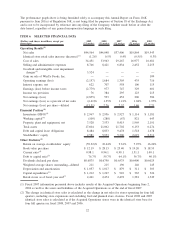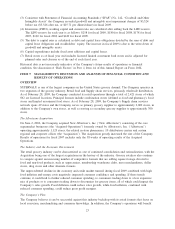Albertsons 2009 Annual Report Download - page 19
Download and view the complete annual report
Please find page 19 of the 2009 Albertsons annual report below. You can navigate through the pages in the report by either clicking on the pages listed below, or by using the keyword search tool below to find specific information within the annual report.workers’ compensation and general and automobile liability is subject to a degree of variability. Among the
causes of this variability are unpredictable external factors affecting future inflation rates, discount rates,
litigation trends, legal interpretations, benefit level changes and actual claim settlement patterns.
Some of the many sources of uncertainty in the Company’s reserve estimates include changes in benefit levels,
medical fee schedules, medical utilization guidelines, vocation rehabilitation and apportionment. If the number
or severity of claims for which the Company is self-insured increases, or the Company is required to accrue or
pay additional amounts because the claims prove to be more severe than the Company’s original assessments,
the Company’s financial condition and results of operations may be adversely affected.
The Company’s policy is to discount its self-insurance liabilities at a risk-free interest rate, which is
appropriate based on the Company’s ability to reliably estimate the amount and timing of cash payments. If, in
the future, the Company were to experience significant volatility in the amount and timing of cash payments
compared to the Company’s earlier estimates, the Company would assess whether it is appropriate to continue
to discount these liabilities.
Litigation may adversely affect the Company’s businesses, financial condition and results of operations.
The Company’s businesses are subject to the risk of litigation by employees, consumers, suppliers, stockhold-
ers or others through private actions, class actions, administrative proceedings, regulatory actions or other
litigation. The outcome of litigation, particularly class action lawsuits and regulatory actions, is difficult to
assess or quantify. Plaintiffs in these types of lawsuits may seek recovery of very large or indeterminate
amounts, and the magnitude of the potential loss relating to such lawsuits may remain unknown for substantial
periods of time. The cost to defend future litigation may be significant. There may also be adverse publicity
associated with litigation that may decrease consumer confidence in the Company’s businesses, regardless of
whether the allegations are valid or whether the Company is ultimately found liable. As a result, litigation may
adversely affect the Company’s businesses, financial condition and results of operations.
Difficulties with the Company’s information technology systems may adversely affect the Company’s
results of operations.
The Company has complex information technology systems that are important to the operation of its
businesses. The Company may encounter difficulties in developing new systems or maintaining and upgrading
existing systems. Such difficulties may lead to significant expenses or losses due to disruption in business
operations and, as a result, may adversely affect the Company’s results of operations.
Threats or potential threats to security or the occurrence of a widespread health epidemic may adversely
affect the Company’s financial condition and results of operations.
The Company’s businesses may be severely impacted by wartime activities, threats or acts of terror or a
widespread regional, national or global health epidemic, such as pandemic flu. Such activities, threats or
epidemics may adversely impact the Company’s businesses by disrupting production and delivery of products
to its stores or to its independent retail customers, by affecting the Company’s ability to appropriately staff its
stores and by causing customers to avoid public gathering places or otherwise change their shopping
behaviors.
Additionally, data theft, information espionage or other criminal activity directed at the grocery or drug store
industry, the transportation industry, or computer or communications systems may adversely affect the
Company’s businesses by causing the Company to implement costly security measures in recognition of actual
or potential threats, by requiring the Company to expend significant time and expense developing, maintaining
or upgrading its information technology systems and by causing the Company to incur significant costs to
reimburse third parties for damages. Such activities may also adversely affect the Company’s financial
condition and results of operations by reducing consumer confidence in the marketplace and by modifying
consumer spending habits.
Severe weather, natural disasters and adverse climate changes may adversely affect the Company’s
financial condition and results of operations.
Severe weather conditions such as hurricanes, earthquakes or tornadoes, as well as other natural disasters, in
areas in which the Company has stores or distribution facilities or from which the Company obtains products
15


